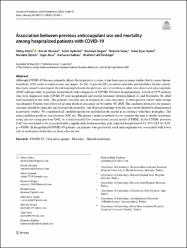| dc.contributor.author | Gülcü, Oktay | |
| dc.contributor.author | Aksakal, Emrah | |
| dc.contributor.author | Aydemir, Selim | |
| dc.contributor.author | Doğan, Remziye | |
| dc.contributor.author | Saraç, İbrahim | |
| dc.contributor.author | Aydın, Sidar Şiyar | |
| dc.contributor.author | Öztürk, Mustafa | |
| dc.contributor.author | Aksu, Uğur | |
| dc.contributor.author | Kalkan, Kamuran | |
| dc.contributor.author | Tanboğa, İbrahim Halil | |
| dc.date.accessioned | 2022-05-13T07:59:58Z | |
| dc.date.available | 2022-05-13T07:59:58Z | |
| dc.date.issued | 02.06.2021 | en_US |
| dc.identifier.citation | Gülcü, O., Aksakal, E., Aydemir, S., Doğan, R., Sarac, I., Aydın, S. Ş., ... & Tanboğa, İ. H. (2022). Association between previous anticoagulant use and mortality among hospitalized patients with COVID-19. Journal of Thrombosis and Thrombolysis, 53(1), 88-95. | en_US |
| dc.identifier.issn | 0929-5305 | |
| dc.identifier.issn | 1573-742X | |
| dc.identifier.uri | https://doi.org/10.1007/s11239-021-02489-1 | |
| dc.identifier.uri | https://hdl.handle.net/20.500.12933/999 | |
| dc.description.abstract | Although COVID-19 disease primarily affects the respiratory system, it has been seen in many studies that it causes thromboembolic (TE) events in many tissues and organs. So that, to prevent TE can reduce mortality and morbidity. In this context, this study aimed to investigate the relationship between the previous use of warfarin or other new direct oral anticoagulants (OAC) and mortality in patients hospitalized with a diagnosis of COVID-19 before hospitalization. A total of 5575 patients who were diagnosed with COVID-19 were hospitalized and started treatment between March 21 and November 30, 2020 were included in the study. The primary outcome was in-hospital all-cause mortality. A retrospective cohort study design was planned. Patients were followed up until death or censoring on November 30, 2020. The candidate predictors for primary outcome should be clinically and biologically plausible, and their relationships with all-cause death should be demonstrated in previous studies. We considered all candidate predictors included in the model in accordance with these principles. The main candidate predictor was previous OAC use. The primary analysis method was to compare the time to deaths of patients using and not using previous OAC by a multivariable Cox proportional hazard model (CPHM). In the CPHM, previous OAC use was found to be associated with a significantly lower mortality risk (adjusted hazard ratio 0.62, 95% CI 0.42–0.92, p = 0.030). In hospitalized COVID-19 patients, in patients who previously used anticoagulantswas associated with lower risk of in-hospital death than in those who did not. | en_US |
| dc.language.iso | en | |
| dc.publisher | Springer | en_US |
| dc.relation.ispartof | Journal of Thrombosis and Thrombolysis | |
| dc.rights | info:eu-repo/semantics/embargoedAccess | en_US |
| dc.subject | COVID-19 | en_US |
| dc.subject | Oral anticoagulant | en_US |
| dc.subject | Mortality | en_US |
| dc.subject | Thromboembolism | en_US |
| dc.title | Association between previous anticoagulant use and mortality among hospitalized patients with COVID-19 | en_US |
| dc.type | Article | |
| dc.identifier.orcid | 0000-0003-0918-5032 | en_US |
| dc.department | AFSÜ, Tıp Fakültesi, Dahili Tıp Bilimleri Bölümü, Kardiyoloji Ana Bilim Dalı | en_US |
| dc.institutionauthor | Aksu, Uğur | |
| dc.identifier.doi | 10.1007/s11239-021-02489-1 | |
| dc.identifier.volume | 53 | en_US |
| dc.identifier.issue | 1 | en_US |
| dc.identifier.startpage | 88 | en_US |
| dc.identifier.endpage | 95 | en_US |
| dc.relation.publicationcategory | Makale - Uluslararası Hakemli Dergi - Kurum Öğretim Elemanı | en_US |
| dc.identifier.pmid | 34080103 | |
| dc.identifier.scopus | 2-s2.0-85107450822 | |
| dc.identifier.scopusquality | Q1 | |
| dc.identifier.wos | WOS:000657244300001 | |
| dc.identifier.wosquality | Q2 | |
| dc.indekslendigikaynak | Web of Science | |
| dc.indekslendigikaynak | Scopus | |
| dc.indekslendigikaynak | PubMed | |
















